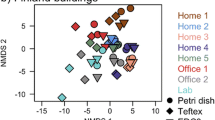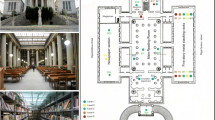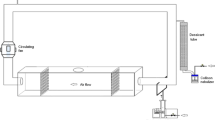Abstract
Research was conducted in an experimental roomto measure the effect of human activity onairborne dispersal of settled fungal sporesfrom carpet and vinyl tile flooring. A seriesof experiments were conducted in whichcommercial loop pile carpet, residential cutpile carpet, or vinyl tile installed in theexperimental room were contaminated with Penicillium chrysogenum spores. The flooringmaterials were contaminated to two differentlevels (106 and 107 colony formingunits per square meter [c.f.u./m2] offlooring surface). Airborne culturable andtotal P. chrysogenum concentrations weremeasured using Andersen single-stage impactorsamplers and Burkard personal slide impactorsamplers, respectively. Bioaerosolconcentrations were measured at floor level, 1meter, and the adult breathing zone (1.5 meter)heights before and after human activityconsisting of walking in a prescribed patternfor 1 minute in the room. Airborne P.chrysogenum concentrations were greater withthe higher surface loading for all threeflooring materials. For all flooring materialsthere was no significant difference betweensampler locations, although the data from the1-meter location were the highest, followed bythe floor level and the breathing zonelocations, respectively. The data from theseexperiments indicate that while a very smallfraction of culturable P. chrysogenumspores present on flooring materials wereaerosolized by walking, relatively highairborne concentrations of spores maybere-entrained from contaminated materials. Theairborne P. chrysogenum concentrationswere significantly higher after walking on cutpile carpet than with the other two flooringmaterials at both contamination levels, withthe differences in concentration often ≥ 2orders of magnitude. No differences weremeasured in airborne culturable P.chrysogenum between vinyl flooring and looppile carpet at both contamination levels. Total spore data from the experiments with the107 c.f.u./m2 contamination levelindicated that walking on loop pile carpetproduced higher airborne spore concentrationsthan similarly contaminated vinyl tile althoughno significant difference was observed at the106 c.f.u./m2 level.
Similar content being viewed by others
References
Andersen A.A.: 1958, New sampler for the collection, sizing, and enumeration of viable airborne particles. J. Bacteriol. 76, 471-484.
Anderson R.L.: 1969, Biological evaluation of carpeting. Appl. Microbiol. 18, 180-186.
Anderson R.L., Mackel D.C., Stoler B.S. and Mallison G.F.: 1982, Carpet in hospitals: an epidemiological evaluation. J. Clin. Microbiol. 15, 408-415.
Bakker P.G.H. and Faoagali J.L.: 1977, The effect of carpet on the number of microbes in the hospital environment. N. Z. Med. J. 85, 88-92.
Burrell R.: 1991, Microbiological agents as health risks in indoor air. Environ. Health Perspectives 95, 29-34.
Buttner M.P. and Stetzenbach L.D.: 1993, Monitoring of fungal spores in an experimental indoor environment to evaluate sampling methods and the effects of human activity on air sampling. Appl. Environ. Microbiol. 59, 219-226.
Dales R.E., Burnett R. and Zwanenburg H.: 1991, Adverse health effects among adults exposed to home dampness and molds. Am. Rev. Respir. Dis. 143, 505-509.
Dart B.L. and Obendorf S.K.: 2000, Retention of Aspergillus niger spores on textiles. Performance of protective clothing: issues and priorities for the 21st Century, In C.N. Nelson and N.W. Henry (eds), ASTM STP 1386, 7th vol. West Conshohocken, PA: Aerican Society for Testing and Materials.
Dybendal T., Hetland T., Vik H., Apold J. and Elsayed S.: 1989, Dust from carpeted and smooth floors. I. Comparative measurements of antigenic and allergenic proteins in dust vacuumed from carpeted and non-carpeted classrooms in Norwegian schools. Clin. Exp. Allergy. 19, 217-224.
Dybendal T. and Elsayed S.: 1992, Dust from carpeted and smooth floors. V. Cat (fel d I) and mite (Der p I and Der f I) allergen levels in school dust. Demonstration of the basophil histamine release induced by dust from classrooms. Clin. Exp. Allergy. 22, 1100-1106.
Gold D.R.: 1992, Indoor air pollution. Clin. Chest Med. 13, 215-229.
Gravesen S.: 1978. Identification and prevalence of culturable mesophilic microfungi in house dust from 100 Danish homes. Allergy 33, 268-272.
Gravesen S., Larsen L., Gyntelberg F. and Skov P.: 1986, Demonstration of microorganisms and dust in schools and offices. An observational study of non-industrial buildings. Allergy 41, 520.
Harrison J., Pickering C.A., Faragher E.B., Austwick P.K., Little S.A. and Lawton L.: 1992, An investigation of the relationship between microbial and particulate indoor air pollution and the sick building syndrome. Respir. Med. 86, 225-235.
Hodgson M.J., Frohliger J., Permar E., Tidwell C., Traven N.D., Olenchock S.A. and Karpf M.: 1992, Symptoms and microenvironmental measures in nonproblem buildings. J. Occup. Med. 33, 527-533.
Kildeso J., Nielsen J. and Schneider T.: 1999, Cross-sectional study of surface dust contamination in Danish schools and day-care centers. Pro. Indoor Air’ 99 4, 261.
Kozak P.P., Gallup J., Cummins L.H. and Gillman S.A.: 1980, Currently available methods for home mold surveys. II. Examples of problem homes surveyed. Ann. Allergy 45, 167-176.
Lacey J. and Crook B.: 1988, Fungal and actinomycete spores as pollutants of the workplace and occupational allergens. Am. Occup. Hyg. 32, 515-533.
Litsky B.Y.: 1973, Bacteriological techniques for testing carpets. Health Lab. Sci. 10, 28-38.
Morton W.E. and Hearle J.W.S.: 1962, Physical Properties of Textile Fibers. Manchester: Butterworth & Co. Ltd and The Textile Institute, 490 pp.
Nordback D. and Torgen M.: 1989, A longitudinal study relating carpeting with sick building syndrome. Environ. Internat. 15, 129-135.
Nordback D., Michel I. and Widstrom J.: 1990, Indoor air quality and personal factors related to the sick building syndrome. Scand. J. Work Environ. Health. 15, 121-128.
Price J.A., Pollock I., Little S.A., Longbottom J.L. and Warner J.O.: 1990, Measurement of airborne mite antigen in homes of asthmatic children. Lancet. 336, 895.
Rylander R., Myrback K., Verner-Carlson B. and Ohrstrom M.: 1974, Bacteriological investigation of wall-to-wall carpeting. Am. J. Public Health 64, 163-168.
Seltzer J.M., 1995, Biologic Contaminants. Occup. Med. 10, 1-25.
Shaffer J.G. and Key I.: 1966, The microbiological effects of carpeting on the hospital environment. Hospitals, J. Am. Health Assoc. 40, 126-139.
Skov P., Valbjorn O. and Pedersen B.V.: 1990, Influence of indoor climate on the sick building syndrome in an office environment. The Danish indoor climate study group. Scan. J. Work Environ. Health 16(5), 363-371.
Thatcher T.L. and Layton D.W.: 1995, Deposition, resuspension, and penetration of particles within a residence. Atmos. Environ. 29, 1487-1497.
Weyel D.A., Ellakkani M., Alarie Y. and Karol, M.: 1984, An aerosol generator for the resuspension of cotton dust. Toxicol. Appl. Pharmacol. 76, 544-547.
Wickman M., Gravesen S., Nordvall S.L., Pershagen G. and Sundell J.: 1992, Indoor viable dust-bound microfungi in relation to residential characteristics, living habits, and symptoms in atopic and control children. J. Allergy Clin. Immunol. 89, 752-759.
Zock J. and Brunekreef B.: 1995. House dust mite allergen levels in dust from schools with smooth and carpeted classroom floors. Clin. Exp. Allergy 25, 549-553.
Author information
Authors and Affiliations
Rights and permissions
About this article
Cite this article
Buttner, M.P., Cruz-Perez, P., Stetzenbach, L.D. et al. Measurement of airborne fungal spore dispersal from three types of flooring materials. Aerobiologia 18, 1–11 (2002). https://doi.org/10.1023/A:1014977900352
Issue Date:
DOI: https://doi.org/10.1023/A:1014977900352




